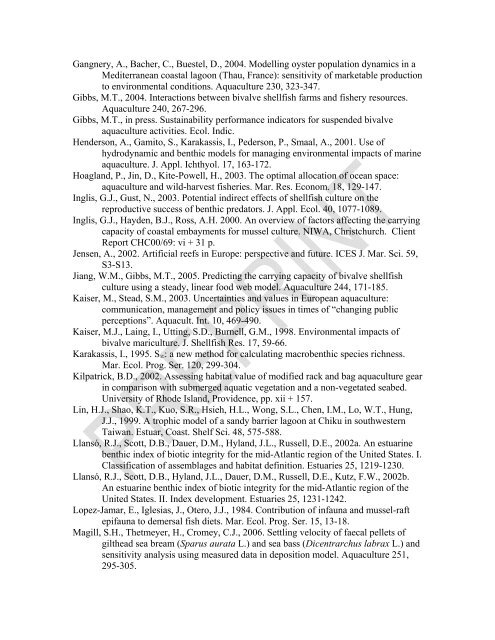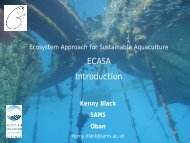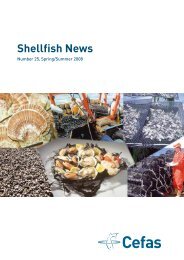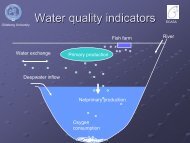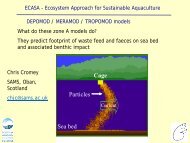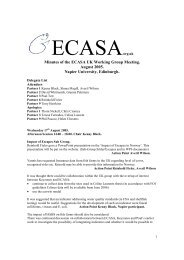carrying capacity models for shellfish - ecasa
carrying capacity models for shellfish - ecasa
carrying capacity models for shellfish - ecasa
- No tags were found...
Create successful ePaper yourself
Turn your PDF publications into a flip-book with our unique Google optimized e-Paper software.
Gangnery, A., Bacher, C., Buestel, D., 2004. Modelling oyster population dynamics in aMediterranean coastal lagoon (Thau, France): sensitivity of marketable productionto environmental conditions. Aquaculture 230, 323-347.Gibbs, M.T., 2004. Interactions between bivalve <strong>shellfish</strong> farms and fishery resources.Aquaculture 240, 267-296.Gibbs, M.T., in press. Sustainability per<strong>for</strong>mance indicators <strong>for</strong> suspended bivalveaquaculture activities. Ecol. Indic.Henderson, A., Gamito, S., Karakassis, I., Pederson, P., Smaal, A., 2001. Use ofhydrodynamic and benthic <strong>models</strong> <strong>for</strong> managing environmental impacts of marineaquaculture. J. Appl. Ichthyol. 17, 163-172.Hoagland, P., Jin, D., Kite-Powell, H., 2003. The optimal allocation of ocean space:aquaculture and wild-harvest fisheries. Mar. Res. Econom. 18, 129-147.Inglis, G.J., Gust, N., 2003. Potential indirect effects of <strong>shellfish</strong> culture on thereproductive success of benthic predators. J. Appl. Ecol. 40, 1077-1089.Inglis, G.J., Hayden, B.J., Ross, A.H. 2000. An overview of factors affecting the <strong>carrying</strong><strong>capacity</strong> of coastal embayments <strong>for</strong> mussel culture. NIWA, Christchurch. ClientReport CHC00/69: vi + 31 p.Jensen, A., 2002. Artificial reefs in Europe: perspective and future. ICES J. Mar. Sci. 59,S3-S13.Jiang, W.M., Gibbs, M.T., 2005. Predicting the <strong>carrying</strong> <strong>capacity</strong> of bivalve <strong>shellfish</strong>culture using a steady, linear food web model. Aquaculture 244, 171-185.Kaiser, M., Stead, S.M., 2003. Uncertainties and values in European aquaculture:communication, management and policy issues in times of “changing publicperceptions”. Aquacult. Int. 10, 469-490.Kaiser, M.J., Laing, I., Utting, S.D., Burnell, G.M., 1998. Environmental impacts ofbivalve mariculture. J. Shellfish Res. 17, 59-66.Karakassis, I., 1995. S ∞ : a new method <strong>for</strong> calculating macrobenthic species richness.Mar. Ecol. Prog. Ser. 120, 299-304.Kilpatrick, B.D., 2002. Assessing habitat value of modified rack and bag aquaculture gearin comparison with submerged aquatic vegetation and a non-vegetated seabed.University of Rhode Island, Providence, pp. xii + 157.Lin, H.J., Shao, K.T., Kuo, S.R., Hsieh, H.L., Wong, S.L., Chen, I.M., Lo, W.T., Hung,J.J., 1999. A trophic model of a sandy barrier lagoon at Chiku in southwesternTaiwan. Estuar, Coast. Shelf Sci. 48, 575-588.Llansó, R.J., Scott, D.B., Dauer, D.M., Hyland, J.L., Russell, D.E., 2002a. An estuarinebenthic index of biotic integrity <strong>for</strong> the mid-Atlantic region of the United States. I.Classification of assemblages and habitat definition. Estuaries 25, 1219-1230.Llansó, R.J., Scott, D.B., Hyland, J.L., Dauer, D.M., Russell, D.E., Kutz, F.W., 2002b.An estuarine benthic index of biotic integrity <strong>for</strong> the mid-Atlantic region of theUnited States. II. Index development. Estuaries 25, 1231-1242.Lopez-Jamar, E., Iglesias, J., Otero, J.J., 1984. Contribution of infauna and mussel-raftepifauna to demersal fish diets. Mar. Ecol. Prog. Ser. 15, 13-18.Magill, S.H., Thetmeyer, H., Cromey, C.J., 2006. Settling velocity of faecal pellets ofgilthead sea bream (Sparus aurata L.) and sea bass (Dicentrarchus labrax L.) andsensitivity analysis using measured data in deposition model. Aquaculture 251,295-305.


